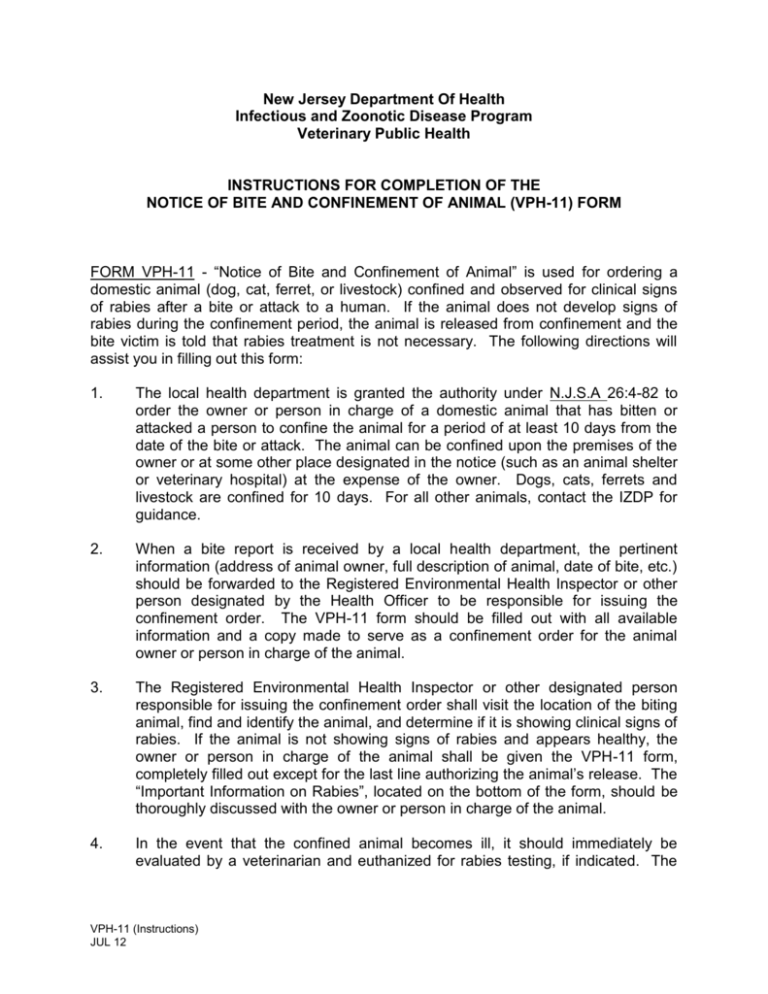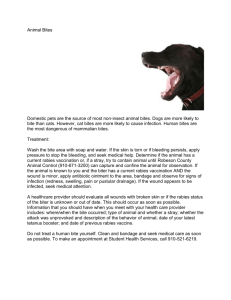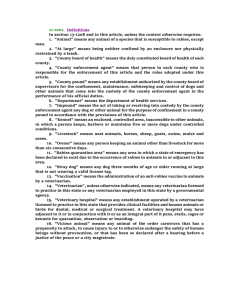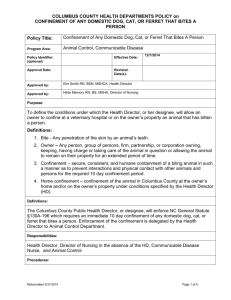VPH-11, Instructions - State of New Jersey
advertisement

New Jersey Department Of Health Infectious and Zoonotic Disease Program Veterinary Public Health INSTRUCTIONS FOR COMPLETION OF THE NOTICE OF BITE AND CONFINEMENT OF ANIMAL (VPH-11) FORM FORM VPH-11 - “Notice of Bite and Confinement of Animal” is used for ordering a domestic animal (dog, cat, ferret, or livestock) confined and observed for clinical signs of rabies after a bite or attack to a human. If the animal does not develop signs of rabies during the confinement period, the animal is released from confinement and the bite victim is told that rabies treatment is not necessary. The following directions will assist you in filling out this form: 1. The local health department is granted the authority under N.J.S.A 26:4-82 to order the owner or person in charge of a domestic animal that has bitten or attacked a person to confine the animal for a period of at least 10 days from the date of the bite or attack. The animal can be confined upon the premises of the owner or at some other place designated in the notice (such as an animal shelter or veterinary hospital) at the expense of the owner. Dogs, cats, ferrets and livestock are confined for 10 days. For all other animals, contact the IZDP for guidance. 2. When a bite report is received by a local health department, the pertinent information (address of animal owner, full description of animal, date of bite, etc.) should be forwarded to the Registered Environmental Health Inspector or other person designated by the Health Officer to be responsible for issuing the confinement order. The VPH-11 form should be filled out with all available information and a copy made to serve as a confinement order for the animal owner or person in charge of the animal. 3. The Registered Environmental Health Inspector or other designated person responsible for issuing the confinement order shall visit the location of the biting animal, find and identify the animal, and determine if it is showing clinical signs of rabies. If the animal is not showing signs of rabies and appears healthy, the owner or person in charge of the animal shall be given the VPH-11 form, completely filled out except for the last line authorizing the animal’s release. The “Important Information on Rabies”, located on the bottom of the form, should be thoroughly discussed with the owner or person in charge of the animal. 4. In the event that the confined animal becomes ill, it should immediately be evaluated by a veterinarian and euthanized for rabies testing, if indicated. The VPH-11 (Instructions) JUL 12 bite victim should be notified of the status of the animal and consult with a physician with regard to initiating rabies post-exposure treatment. 5. On or shortly after the release date, the Registered Environmental Health Inspector or other designated person responsible for issuing the confinement order shall visit the location of the biting animal, verify that it is alive and free of clinical signs of rabies and release the confinement order by signing and dating the bottom line of the form. This signed copy of the form should be left with the animal owner to formally release the confinement order. 6. The Registered Environmental Health Inspector or other designated person responsible for issuing the confinement order shall then complete the release information on the copy of the VPH-11 form that they retain. This document should be saved for the period of time designated by their agencies’ record retention schedule. 7. The confinement release information should be relayed immediately to the bite victim and/or the treating physician. Individuals bitten or exposed to the saliva from domestic animals that do not develop clinical signs of rabies during the confinement period do not need rabies post-exposure treatment. If they have started treatment, it can be discontinued at this time. Questions about animal bite and confinement procedures should be addressed to the Health Officer with jurisdiction over the case. Health Officers can contact the Infectious and Zoonotic Diseases Program at (609) 826-4872 if they have questions. VPH-11 (Instructions) JUL 12



